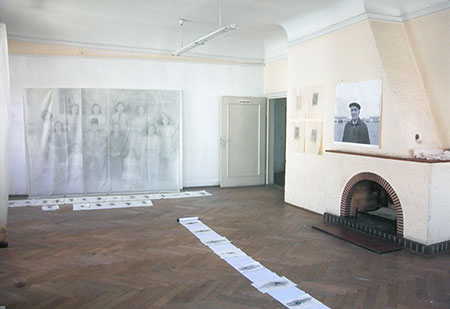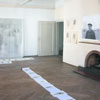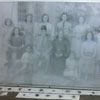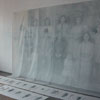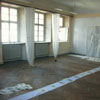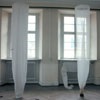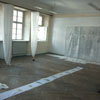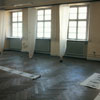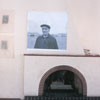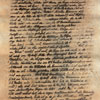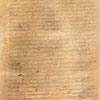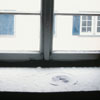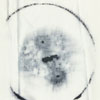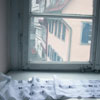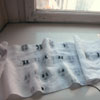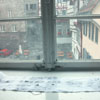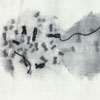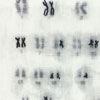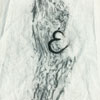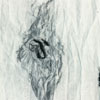Family Photos
FAMILY PHOTOS, LINENS, AND ALPHABETS
During my sabbatical in 2002-2003, I set out to make a new body of work based on the language of embroidery and the cultural function of cloth, the veil, and linens among Semitic people. This book documents the work done at the Fachhochschule Schwäbish Hall. The school runs the Kunstseminar, a residency program for artists to spend two to six weeks making work and interacting with students. The studios were in an 18th-century newspaper publishing house where the printer's family once lived and worked. My studio was in the living room. The French windows, parquet floors, and tiled fireplace inspired me to work with photographs as if they were tapestries in a domestic home. Prior to going, I chose to work with family photos, as I found this to be the most compelling point for me to begin my exploration. I brought most of the work with me in varying stages of completion.
Qamars, At Home in Jerusalem, 1942
This drawing is taken from a photo of my husband's Christian Palestinian grandparents, aunts, and uncles. The picture is the last family photo taken in 1942 with all the children in the courtyard of their family home in Jerusalem. In 1948 they were forced from their family home, along with the masses of Palestinians who became refugees in the wake of the creation of Israel. Starting at that point they dispersed throughout the Middle East, the US, Canada, and Europe, as they sought education, employment, and their individual paths. They were never photographed all together again. The photograph was enlarged so that each person is life-sized. It was printed on canvas as a gray tone screen and extensively modified with litho crayon, oil paint and embroidery floss.
Alphabet
In 2001 I began embroidering the Hebrew and Arabic alphabet overlaid onto rubbings of trees. On each panel a curved calligraphic letter emerges from an area of cellular pattern. The abstract cellular patterns under the letters suggest the genetic and linguistic connection among Semitic people. While working in Germany I made scrolls for each alphabet. They were rolled out on to the studio floor. The visitors to the studio were invited to pick up the individual letters and arrange them.
Uncle At Dachau, Letter from Camp
My uncle was a holocaust survivor. The photo mounted above the fireplace is of him in front of Dachau at the 25th anniversary of the liberation of the camp. I spent a considerable amount of time with my grandmother, aunt, and uncle while I was growing up. Stories of World War II, the Nazi regime, and their lives between wars filled my head. Upon my aunt's death in 1997 I received all my uncle's letters, legal documents, and journals. I thought these would be significant to take back to Germany as the basis of a body of work.
Torah Binder, A Boy's Chromosomes
In 1997 I viewed an exhibition of embroidered Torah binders dating from 981-1935 AD at the Prähistorlishe Staatssammlung in München, Germany. Mappot - Blessed Be the One Who Comes, The Band of Jewish Tradition mainly contained binders from 1665-1746, which were found in 1987 at the Ichenhausen Synagogue. The tradition of Mapport in Germany dates to the 16th century among German speaking Ashkenazi communities. These elaborately embroidered Torah binders, made from a circumcision diaper upon the birth of a son, tell the story of rural Jews living in southern Germany. Although all contain traditional prayer, each carries images and texts telling of assimilation.
They are prayers for a boy's religious life and documents of a community and a culture. I was so moved by this exhibition that I began to research the tradition. After having a son in 1999, I began to make my own series of binders. The Irish linen is printed with the chromosome test results one is given after an amniocentesis. The ink stained the cloth as I imagine the circumcision diaper to be stained.
Torah Binder, A Boy's Chromosomes, was photographed on the windowsill of the studio.
Egg Dividing and Exodus
Both Egg Dividing and Exodus are works based on the scarf or veil form. The Egg Dividing image is a photograph taken with a microscope of a human egg dividing, and then transferred onto silk. Exodus is a long scarf with two embroidery hoops framing the images. On the left the term "exodus" is in English and translated into Arabic. On the right there is an embroidered map of the world with hundreds of satellite stations floating around. This map seemed to be a perfect representation of diaspora of various population groups in the world.
